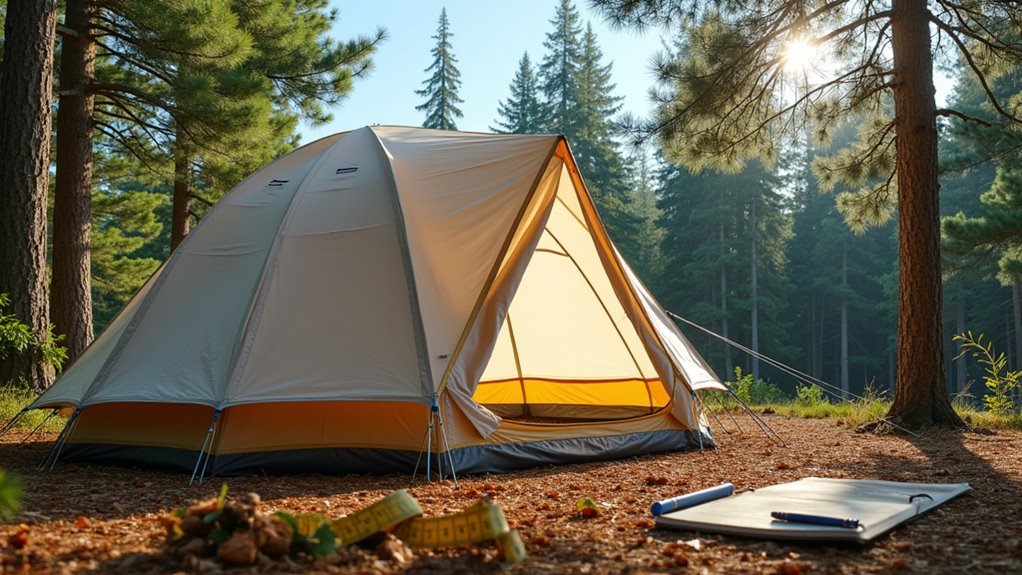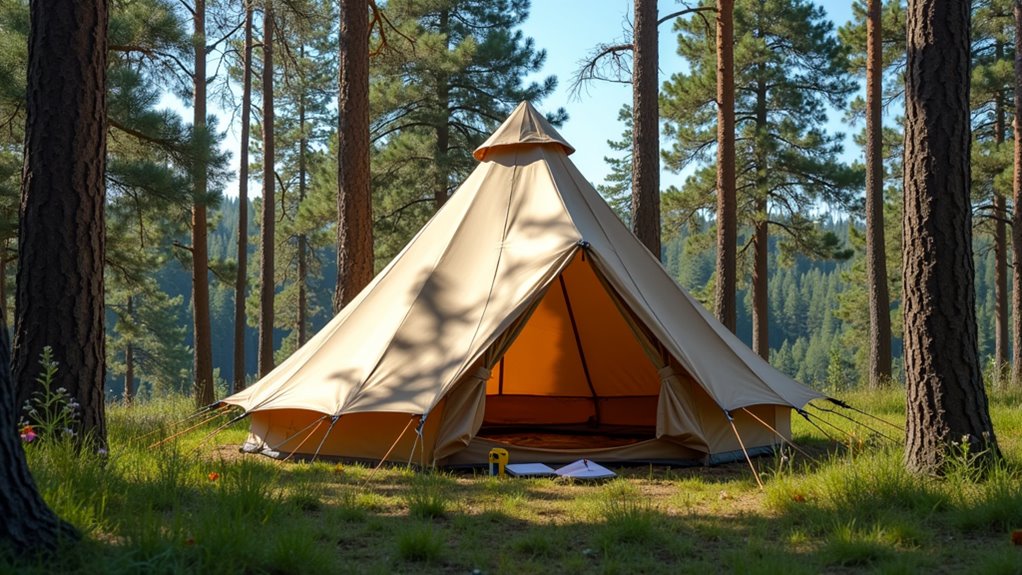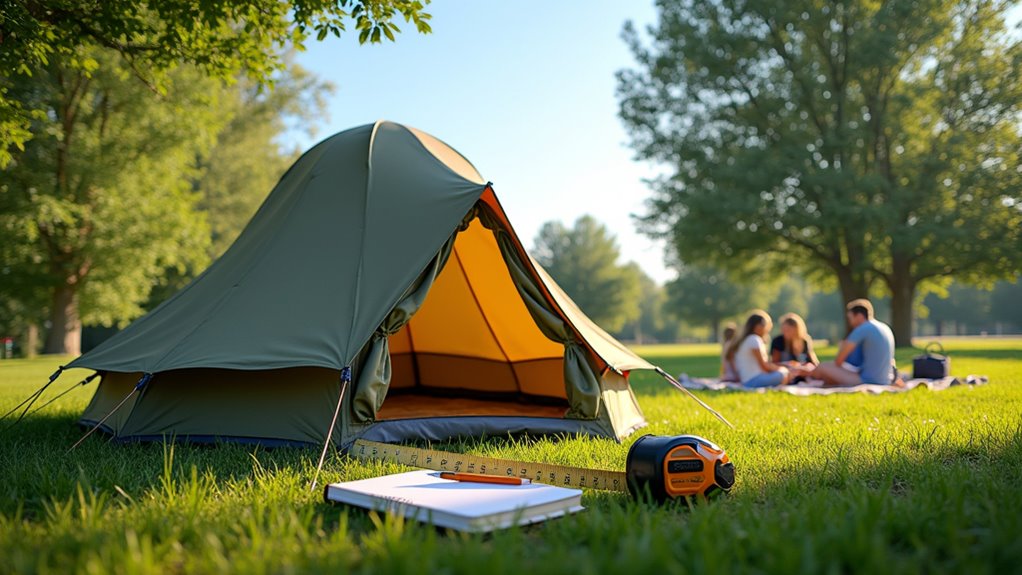How To Find Volume Of A Tent
This post contains affiliate links. As an Amazon Associate, we earn from qualifying purchases.
The volume of a tent can be calculated by identifying its shape and applying the appropriate geometric formula. For cuboid tents, multiply length, width, and height; for pyramid-shaped tents, use one-third of the base area times the height; and for triangular prism tents, multiply the area of the triangular base by the length. Precise measurements are important for accuracy. Further explanation and detailed examples will follow to help you understand the process more thoroughly.
Essential Facts in 30 Seconds
- Cuboid tent volume = Length × Width × Height.
- Pyramid tent volume = (1/3) × Base Area × Height.
- Triangular prism tent volume = 0.5 × base length × height × tent length.
- Use consistent units for all measurements.
- Knowing tent volume aids space planning and material estimation.
Understanding Tent Shapes and Structures

Tents come in many shapes and styles. Each shape has its own use and strength. Frame tents have metal bars inside. They hold up well in wind and rain.
Air tents stay up with air pressure. They go up fast and cover large spaces. Tensile tents use strong fabric pulled tight. They carry heavy weight without falling.
Tents use different materials like polyester and PVC. These materials make tents strong and flexible.
Dome tents have round tops. They keep out rain and wind well. Cabin tents have tall walls. They give more space to stand inside.
Tunnel tents stretch long. They offer lots of room but can sway in strong wind. Choosing the right tent shape and material can greatly affect your camping experience.
Pick a tent shape and material that fits your needs. Strong shapes and good materials make a tent safe and comfy.
Volume Calculation for Cuboid Tents
Calculating the volume of a cuboid tent shows how much space you have inside. A cuboid tent has straight edges and rectangular sides. Measure the length, width, and height using a tape measure or laser distance meter. Make sure all measurements use the same unit, like meters or feet.
Use this formula: Volume = Length × Width × Height. Multiply length by width, then multiply the result by height. The answer gives the volume in cubic meters or cubic feet. This number helps you know how much room is inside for people and gear.
Try online calculators to check your work fast. Knowing the volume makes camping more comfortable and organized.
Calculating Volume of Pyramid-Shaped Tents

Calculating the volume of pyramid-shaped tents helps you use space better.
Use the formula: V = 1/3 × Base Area × Height. Measure your tent carefully. A square base has area a², where a is the side length. A rectangular base has area L × W, length times width.
Find the height from the base to the top point. Keep all measurements in the same units, like feet or meters.
For example, a square pyramid tent with a 5 ft side and 10 ft height holds 83.33 cubic feet. Knowing the volume makes your camping more comfortable and organized.
Volume of Triangular Prism Tents
Triangular prism tents have a special shape that uses space well and stays stable. To find the volume of your tent, focus on the triangle shape at the ends and do some simple math.
Follow these steps:
- Find the area of the triangle at one end. Use this formula: 0.5 × base length × height.
- Multiply this area by the tent’s length (the distance between the two triangular ends).
- Make sure all measurements use the same units for accurate volume in cubic units.
For example, if the base length is 10 inches, the height is 7 inches, and the tent length is 3 inches, calculate: (10 × 7 × 3) ÷ 2 = 105 cubic inches.
This volume tells how much space is inside the tent. Accurate numbers help with good results and better planning.
Practical Applications of Tent Volume Measurements

Tent volume measurements serve many important purposes. They help use space well, making room for people and gear. Knowing the volume guides how to arrange the inside for comfort. It also helps keep air flowing and controls temperature. Additionally, understanding the tent size requirements ensures that the space is appropriate for the number of guests.
Here is a list of key uses:
| Application | Description |
|---|---|
| Space Utilization | Maximizes room for people and equipment |
| Material Estimation | Calculates fabric needed for the tent |
| Safety Preparation | Plans storage for emergency supplies |
| Marketing | Shows buyers the size and capacity |
| Design Factors | Affects airflow and tent strength |
These uses make tents safer, more comfortable, and easier to build. Accurate volume data saves money and improves user experience. Additionally, understanding tent size recommendations can ensure all guests are comfortably accommodated.
Frequently Asked Questions
How Do I Convert Tent Volume From Cubic Inches to Cubic Feet?
Convert tent volume from cubic inches to cubic feet by dividing by 1,728. One cubic foot equals 1,728 cubic inches. This simple math helps you understand tent sizes better. Use this method to compare volumes easily. It works for any object, not just tents. Keep this number in mind for quick conversions.
What Factors Affect the Accuracy of Volume Calculations?
Volume calculation accuracy depends on several key factors. Grid resolution matters a lot; finer grids give better results. Using consistent units avoids confusion and errors. The shape and surface of the object also play a big role. Smooth, simple shapes are easier to measure accurately. User skill counts too. Careless steps can cause mistakes. Environmental conditions like temperature and humidity can change measurements slightly. Watch these details closely for the best accuracy.
Can I Estimate Volume Without Precise Measurements?
Estimating volume without exact measurements is possible. Measure the length, width, and height roughly. Multiply these numbers for a quick volume estimate. Break the object into simple shapes like cubes or cylinders. Add their volumes together for a better guess. This method works well for tents or boxes. It helps when tools or rulers are unavailable. Simple math gives a good volume idea. Keep numbers easy for fast calculations. You don’t need perfect numbers to understand size.
How Does Tent Shape Impact Ventilation and Airflow?
Tent shape controls how air moves inside. Pyramid tents boost airflow by 30%. This helps keep the tent dry and fresh. Steep tent walls stop water drops from forming inside. This reduces dampness and makes camping more comfortable. Good airflow also cuts down on heat buildup. It keeps the air cool on hot days. So, pick a tent shape that lets air flow well. Your camping experience will improve a lot.
Are There Standard Volume Guidelines for Different Tent Sizes?
Standard volume guidelines exist for different tent sizes. Consider tent size and peak height carefully. Proper airflow is key for guest comfort and event needs. For example, a 20×20 tent suits about 25-30 people comfortably. Larger tents need more space per person to avoid crowding. Peak height helps air circulate better inside the tent. Always plan space according to your guest count and activities. This ensures everyone feels comfortable and safe.
Conclusion
Calculating a tent’s volume helps you know how much space it has inside. A typical 10×10-foot pop-up tent holds about 800 cubic feet of air. This space fits many guests comfortably. Different tents have different shapes. Each shape has its own way to calculate volume. Knowing these formulas makes sure the tent fits your needs. Measuring carefully leads to better plans and a fun event. Simple math gives clear answers. No guesswork needed.
